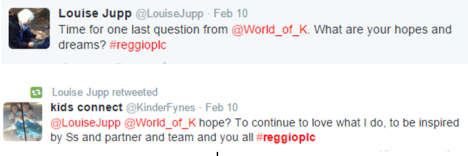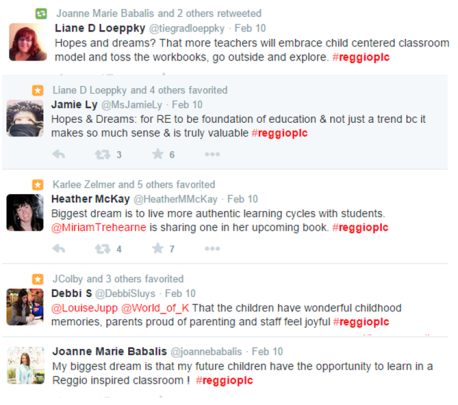Written by Nancy Niessen
Last Tuesday’s #ReggioPLC chat topic was about our own personal Reggio-inspired journeys: how they started, what we were inspired by, and what our challenges have been along the way. It was evident early on in the chat how our connections and relationships with others have influenced the journeys we are on, and how instrumental they were to starting our own journeys. Another thing that stood out for me was people mentioning how comfortable they felt, “at home” on their Reggio-inspired journeys and with others who are on parallel journeys.
I like to take some time post-chat to reflect on key points that emerged, in terms of my learning and what pushed my thinking, and in terms of themes that seemed to surface in the conversation. I chuckled as I reflected on the technical challenges that both @LouiseJupp and I, the co-moderators of the chat, were experiencing. Louise’s computer froze early on. Tweetchat was not working on my PC, and my iPad couldn’t keep up to the speed of the chat. We both persevered and found ways around our technical challenges, including relying on each other to carry the chat while the other was temporarily AWOL. It seems to me that this parallels some of the challenges those of us on Reggio-inspired journeys face. We can feel isolated, misunderstood, unsure, and unsupported. By hanging in, reaching out, connecting with others, and especially by persevering, the hurdles we face can be overcome, and they are well-worth the challenge.
The final question posed in the chat was about people’s hopes and dreams. I was quite moved by what people offered in answer to that question, a sampling of which is below.
As I pondered the hopes and dreams that participants shared at the end of the chat, it struck me that they all relate back to our view of the child in one way or another. This is one of the core principles of Reggio Emilia. I started reflecting on what I have read about our view of the child, and how much there is readily available about the importance of how we view children. Being a public school teacher in Ontario, I zeroed in on Ministry of Education resources for the purpose of this blog to highlight how mainstream Reggio’s influence is becoming. I’ve highlighted only some of the resources that I’ve read over the last few years, but others such as the Ministry’s newest monographs, are also influenced by Reggio philosophy.
Our curriculum document, The Full-Day Early-Learning Kindergarten Program (2010) states on page 2, “The Full-Day Early Learning–Kindergarten program reflects the belief that four- and five-year-olds are capable and active learners, full of potential and ready to take ownership of their learning.”
The Ontario Early Years Policy Framework (2013) states on page 7,
“We view children as competent, capable of complex thinking, curious, and rich in potential. They grow up in families with diverse social, cultural, and linguistic perspectives. Every child should feel that he or she belongs, is a valuable contributor to his or her surroundings, and deserves the opportunity to succeed. When we recognize children as capable and curious, we are more likely to deliver programs and services that value and build on their strengths and abilities.”
This quote also appears in our newest Ministry resource, How Does Learning Happen? Ontario’s Pedagogy for the Early Years (2014).
In the Think, Feel, Act, Lessons From Research about Young Children (2013), Karyn Callaghan has an article entitled, The Environment is a Teacher. She states,
“A starting point for critical reflection is a clear statement of how we view children. If we posted our view of the child in large letters in our classrooms, we could invite collaboration as we work to bring our practice into alignment with those stated views.”
In that same document, Carol Anne Wien talks about children’s “competent and thoughtful views of the world.” The article is entitled, Making Learning Visible Through Pedagogical Documentation.
The above resources are just some from our Ministry of Education that indicate that our view of the child is of paramount importance. As I suggested in my last (and first!) blog, it is difficult to separate out elements in our programs as they are all so interconnected and interdependent. However, it truly is our view of the child that is at the heart of our programs, how we:
- interact with the students and form relationships with them and their families
- set up our room and the invitations for learning
- run our programs, in terms of being teacher-driven, or more emergent in nature
- document and share that documentation, and what we do with that documentation
Is the reality of our programs in alignment with our view of the child?
Lella Gandini’s words on this topic resonate for me. I am continually working to ground them in the reality of my practice:
“All children have preparedness, potential, curiosity; they have interest in relationship, in constructing their own learning, and in negotiating with everything the environment brings them. Children should be considered as active citizens with rights, as contributing members, with their families, of their local community. Children with special rights (rather than using the term special needs) have precedence in becoming part of an infant/toddler center or preschool.”
*******
Let’s consider deeply our view of the child, the breadth of what we think they are capable of, and how our view of the child influences our practices, and in so doing, perhaps we will be a step closer to having the hopes and dreams that you shared in the last chat come true.
Please join Louise Jupp and I for the next Tuesday evening #ReggioPLC chat on February 24th from 9:00 – 10:00 p.m. (EST) and share your view of the child.
Questions for your consideration and reflection…
- How would you articulate your view of the child in words?
- The words “competent and capable” often come to mind when considering our view of the child. What does that mean to you? Grounded in reality, how does that look and sound?
- How is your view of the child apparent in your (classroom) environment and in your program?
- Are there aspects of your environment (time, space, and resources) that you would like to tweak to better align with your view of the child, and if so what are these, what changes are you considering, and why?
- What challenges your view of the child?
- How do you make visible your view of the child for others?



Hi Nancy,
So wonderful to follow you on twitter and now on your blog. As you know I have been a HUGE fan of yours for many years. I LOVE to see passionate, inspired, wonderful teachers sharing. You are a gift.
LikeLike
Hi Cheryl,
Thanks so much for your wonderfully supportive words. 🙂 I truly appreciate them as I begin this venture into the world of blogging!
Nancy
LikeLike
I am so glad to see your entry to the longer prose form here.
What I mean is, I’m often struck by how clear, how profound your thoughts are in Twitter conversations and in #reggioPLC chats, so I’ve wondered if you might take a leap into longer reflective writing. I often look to you during these heady conversations to find the words for ideas still forming in my head. Perhaps I recognize the journey I’m on, and your way of seeing, always with the wide view including families and stakeholders, and I see it as signs that I’m going the right way. Thanks for thinking aloud, and being a beacon for me.
LikeLike
Hi Laurel,
I’m touched by your words and appreciate your support. I went from writing articles for a grassroots Kindergarten publication, to tweeting and trying to make meaning with 140 characters. I have to admit it’s refreshing to return to a longer format, if a little nerve-wracking to do it so publicly! Supporters and experienced bloggers like you have given the courage to finally give this a try!
Nancy
LikeLike